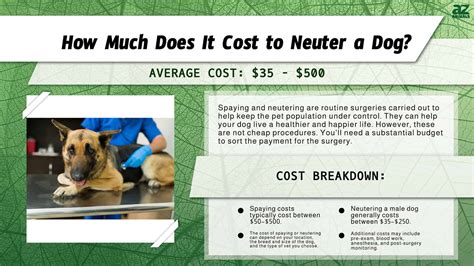How Much Does It Cost to Spay a Dog? A Comprehensive Guide
Spaying your dog is a crucial decision for her health and well-being, and a responsible act for pet ownership. But the cost can vary significantly depending on several factors. This guide breaks down the expenses involved and helps you understand what to expect.
Factors Affecting the Cost of Spaying a Dog
Several factors influence the final price of spaying your canine companion. Understanding these will help you budget effectively.
1. Your Dog's Size and Breed:
Larger breeds generally require more anesthesia and have longer surgery times, resulting in higher costs. Certain breeds might also be predisposed to certain health issues that could add to the expense if complications arise during or after the procedure.
2. The Veterinarian's Location and Fees:
Veterinary clinics in urban areas or those with specialized services tend to charge more than those in rural areas. The veterinarian's experience and reputation also play a role. Expect variation in pricing even within the same geographic location.
3. The Type of Anesthesia Used:
Different types of anesthesia have varying costs. While general anesthesia is most common for spaying, the specific type used will influence the overall price.
4. Pre-Operative Tests:
Before surgery, your veterinarian may recommend blood tests to assess your dog's overall health and ensure she's fit for the procedure. These tests add to the overall cost.
5. Post-Operative Care:
This includes pain medication, any potential complications requiring additional treatment, and follow-up visits. Unexpected issues can significantly impact the final bill.
6. Additional Services:
Some clinics offer additional services like microchipping or vaccinations alongside spaying. These optional services increase the total cost.
Breaking Down the Costs: What to Expect
While providing an exact figure is impossible without specific details, you can expect a range:
-
Low-Cost Clinics: These clinics often offer spaying services at significantly reduced prices, sometimes through subsidized programs. You might find costs ranging from $50 to $200. However, availability can be limited and waiting times may be longer.
-
General Veterinary Practices: The majority of veterinary practices will charge within a moderate range. Costs here generally fall between $200 and $500.
-
Specialty Clinics/Emergency Care: For dogs with pre-existing conditions or complications, costs can escalate rapidly, potentially reaching $500 or more.
Remember: This is just a general guideline. Always contact your local veterinarian for an accurate quote. They can assess your dog's individual needs and provide a detailed estimate.
Tips for Saving Money on Spaying Your Dog
- Check for Low-Cost Spay/Neuter Clinics: Many organizations offer subsidized spaying and neutering services. Search online for options in your area.
- Inquire About Payment Plans: Some veterinary clinics provide payment plans to help manage the cost of the procedure.
- Consider Spaying at a Younger Age: Spaying a younger dog is generally safer and can sometimes be less expensive.
Conclusion: Prioritize Your Dog's Health
Spaying your dog is an investment in her long-term health and well-being. While the cost is a factor, prioritizing her health should be paramount. By understanding the factors influencing the price and exploring available options, you can make an informed decision and ensure your canine companion receives the best possible care. Remember to always contact your vet for personalized advice and a detailed cost estimate.
